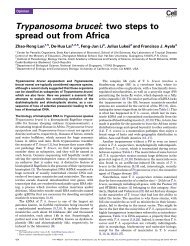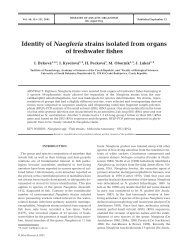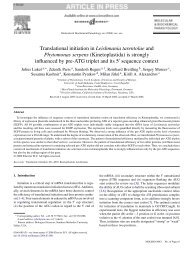Goussia Labbe´ , 1896 (Apicomplexa, Eimeriorina) - Institute of ...
Goussia Labbe´ , 1896 (Apicomplexa, Eimeriorina) - Institute of ...
Goussia Labbe´ , 1896 (Apicomplexa, Eimeriorina) - Institute of ...
You also want an ePaper? Increase the reach of your titles
YUMPU automatically turns print PDFs into web optimized ePapers that Google loves.
132 M. Jirku˚ et al.<br />
output, necessarily lead to contamination <strong>of</strong> the<br />
aquatic environment, with oocysts being immediately<br />
infectious for new hosts due to their<br />
endogenous sporulation. In general, the tadpoles<br />
<strong>of</strong> anuran species involved in this study <strong>of</strong>ten<br />
occur syntopically, and it is unlikely that receptive<br />
hosts could remain uninfected in such conditions<br />
if the host range <strong>of</strong> <strong>Goussia</strong> found involved hosts<br />
from different genera. While the anuran <strong>Goussia</strong><br />
isolates cannot be distinguished from each other<br />
and from G. neglecta by oocyst/sporocyst morphology,<br />
the 3—4% divergence <strong>of</strong> their SSU rDNA<br />
sequences indicates that each anuran genus<br />
hosts a distinct <strong>Goussia</strong> species. Infection experiments<br />
suggest that the closely related R. dalmatina<br />
and R. temporaria (Veith et al. 2003) are<br />
parasitized by G. noelleri. The most plausible<br />
explanation for the peculiar pattern <strong>of</strong> distribution<br />
in different localities, absence <strong>of</strong> morphological<br />
differences and sequence divergence among the<br />
anuran isolates is that three cryptic <strong>Goussia</strong> spp.<br />
parasitize Rana spp., P. kl. esculentus and B. bufo,<br />
respectively. This conclusion conforms with Molnár<br />
et al. (2005), who showed that morphologically<br />
indistinguishable <strong>Goussia</strong> carpelli isolates from<br />
different cyprinid fish represent distinct species<br />
with a narrow host specificity.<br />
Interestingly, post mortem examination showed<br />
that the coprological results obtained by flotation<br />
do not reflect the real prevalence <strong>of</strong> <strong>Goussia</strong><br />
in tapoles, possibly as a result <strong>of</strong> intermittent<br />
oocyst shedding, rendering coprology unsuitable<br />
for prevalence assessment <strong>of</strong> <strong>Goussia</strong> species.<br />
In agreement with others (Paperna et al. 1997)<br />
we found that <strong>Goussia</strong> infections are common<br />
among anuran tadpoles. Given their narrow host<br />
specificity, the diversity <strong>of</strong> anuran <strong>Goussia</strong> might<br />
thus be remarkable. However, the morphology<br />
<strong>of</strong> oocysts/sporocysts as well as their size<br />
ranges overlap in known anuran <strong>Goussia</strong> spp.<br />
and should not be considered a primary taxonomic<br />
criterion.<br />
While oocysts/sporocysts <strong>of</strong> anuran <strong>Goussia</strong><br />
are morphologically rather uniform, possibly as a<br />
consequence <strong>of</strong> being subject to similar selection<br />
forces, the situation may be different for the<br />
endogenous stages, which develop in the digestive<br />
tract <strong>of</strong> tadpoles. Different physiological environments<br />
<strong>of</strong> their hosts might therefore represent major<br />
selection mechanisms leading to species-specific<br />
morphological adaptations. Information on endogenous<br />
development should thus become regular<br />
part <strong>of</strong> future studies, that should incluce also<br />
molecular data. Following the proposed taxonomic<br />
requirements, we consider differences in the SSU<br />
ARTICLE IN PRESS<br />
rDNA sequence <strong>of</strong> the B. bufo isolate insufficient for<br />
the description <strong>of</strong> a new species.<br />
Differential Diagnosis <strong>of</strong> G. noelleri<br />
At the ultrastructural level, G. noelleri is characterized<br />
by the absence <strong>of</strong> wall-forming bodies and<br />
parasitophorous vacuole in the gamogonic and<br />
sporogonic stages, presence <strong>of</strong> pellicular projections<br />
in macrogamonts, two refractile bodies per<br />
sporozoite, each surrounded by fine amylopectin<br />
granules, an unilayered sporocyst wall without<br />
transverse striation and a simple sporocyst suture.<br />
The lack <strong>of</strong> wall-forming bodies is a common trait<br />
<strong>of</strong> fish and amphibian coccidia (Paperna and<br />
Lainson 1995; Paperna et al. 1997), while the<br />
absence <strong>of</strong> a parasitophorous vacuole seems to<br />
be specific for G. noelleri. Another feature differentiating<br />
the anuran G. hyperolisi and G. noelleri<br />
from most piscine congeners is the absence <strong>of</strong> the<br />
sporocyst wall striation (Lom and Dyková 1992).<br />
Refractile bodies were observed in G. hyperolisi,<br />
yet in contrast to G. noelleri, no amylopectin<br />
granules were observed on their surface (Paperna<br />
et al. 1997). However, a layer <strong>of</strong> amylopectin<br />
granules reminiscent <strong>of</strong> that observed around<br />
refractile bodies <strong>of</strong> G. noelleri was described from<br />
anuran Eimeria bufomarini and piscine <strong>Goussia</strong><br />
sinensis (Baska and Molnár 1989; Paperna and<br />
Lainson 1995).<br />
Status <strong>of</strong> the genus <strong>Goussia</strong>: The solitary position<br />
<strong>of</strong> G. janae at the base <strong>of</strong> the eimeriorinid<br />
coccidia, along with the branching <strong>of</strong> the anuran<br />
<strong>Goussia</strong> spp. and the piscine G. metchnikovi<br />
within the Eimeriidae s.l. clade suggest that the<br />
genus <strong>Goussia</strong> is paraphyletic, characterized by<br />
non-unique features such as four bivalved dizoic<br />
sporocysts per oocyst. Moreover, this feature<br />
is shared with the reptile-host coccidian genera<br />
Acroeimeria and Choleoeimeria (Paperna and<br />
Landsberg 1989). Importantly, the polytomy <strong>of</strong><br />
the anuran <strong>Goussia</strong> spp. and G. metchnikovi<br />
shows that basal eimeriid lineages are undersampled<br />
and taxonomic rearrangements using the<br />
limited available dataset would be unstable.<br />
As there are two poorly characterized type<br />
species <strong>of</strong> the genus <strong>Goussia</strong> (Levine 1983),<br />
topotypic material is needed to redefine them,<br />
and re-evaluate the taxonomy <strong>of</strong> the <strong>Goussia</strong>-like<br />
piscine and amphibian coccidia. The genus<br />
should be redescribed by combination <strong>of</strong> oocyst/<br />
sporocyst morphological features, character <strong>of</strong><br />
the endogenous development and phylogenetic<br />
affinity <strong>of</strong> the type species. Paperna and Landsberg<br />
(1989) erected the genera Acroeimeria and








